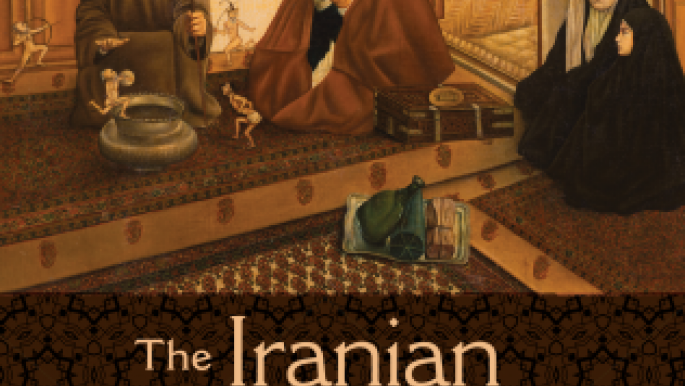
Iranian metaphysicals: Explorations in science, Islam, and the uncanny
Buddhist, Hindu, Occultist, Sufi and Shia mysticism became popular sources of consultation and contention in the post Iran-Iraq war (1980-1988) recovery period.
Iranian society under the Islamic Republic underwent a form of 'secularisation', as Charles Taylor observed in the West, which was not the banishment of religion from public space, but rather the pluralisation of spiritual and religious options available to people.
The liberalisation period produced a wave of mystics, shamans, psychics, clairvoyants and metaphysicians, and Alireza Doostdar's new book 'The Iranian Metaphysicals: Explorations in Science, Islam, and the Uncanny’, explores the landscape of Iran's spiritual economy.
Doostdar argues that the privatisation of Iran's economy led-to unpredictability as rival businesses competed to control once state-run industries, middle classes were encouraged to 'individualise' and standout in the new environment. As the doctrines of the Iranian revolution faded away, the aftermath of the devastating Iran-Iraq war produced social anxiety.
In response to the spiritual void and uncertainty of the 'new Iran' - many sought out 'uncanny' ways to deal with the new reality. The Iranian Metaphysicals tries to make sense of the complex and discursive realm of contemporary Iranian spirituality. An anthropological work; we encounter a wide range of people, from clerics, to laymen to scientists.
 |
In response to the spiritual void and uncertainty of the 'new Iran' - many sought out 'uncanny' ways to deal with the new reality |  |
Doostdar's discussion touches on a sensitive subject, as some regime hardliners hope to stamp out the new spiritualism, while hardcore materialists see it as "superstition" and a dangerous retreat from reason.
But as becomes clear from the outset, Doostdar's personalities do not see their spiritualism as superstitious or anti-rational, quite the contrary; they see themselves as scientists exploring a new frontier.
The Iranian Metaphysicals opens with Doostdar attending an exorcism in a middle-class Tehran suburb. Mr Sheyda, an exorcist and teacher of cosmic mysticism (an Iranian developed 'science' devoted to the study of mysticism), takes his graduate students along on field trips to observe his therapy (exorcism) in action.
 |
|
A woman in her 30s named Zeynab, lets out a terrifying scream, and Mr Sheyda's students gather around the patient as she lets out a series of moans and shrieks. They hold her arms and legs until she calms down and then they let her go once she has stabilised. Zeynab gets up and wanders around, hissing, snarling, kicking and screaming.
Mr Sheyda challenges the supposed spirit or 'jinn' that has taken possession of Zeynab, ordering it to leave. The spirit is persistent and refuses to leave, instead Zeynab howls.
Mr Sheyda questions the spirit: "She purchased you herself, didn't she?" Mr Sheyda reveals to everyone that he has been working with Zeynab for three weeks, she bought the jinn from a prayer writer to assault her ex-husband with, but instead the jinn took possession of her. Eventually the spirit leaves Zeynab and everyone breathes a sigh of relief.
Mr Sheyda, one of many characters Doostdar encounters, sees possession by a spirit as a natural phenomenon, and like everyone involved in the cosmic mystical movement, argues that it needs to be understood using rational and scientific methods.
Cosmic mysticists draw a line between themselves, and superstition, which they see as ignorant, backward and wrong. Their appeals to science, and aversion to the label superstition reveal the interesting ways modern rationalism has interacted with Iranian society.
Students taking up the mystical sciences are often (although not exclusively) engineers, doctors, psychologists and from other scientific fields.
Some groups within the Iranian government have attempted to combat the growth of mystical sciences by creating an alternative mysticism centred on shrines and miracles associated with them.
In the last 10 years - with the encouragement of Iran's government - there has been huge growth in the number of visitors to Imam Reza shrine in Mashhad. While others in power wish to do away with both regime-sponsored and non-regime sponsored mysticism, both are seen as a deviation from religious and revolutionary doctrines.
Doostdar charts the way in which the scientific discourse changed religious perception over the course of the 20th century to produce the new spiritual environment in which Iran finds itself today.
 |
The book opens with Doostdar attending an exorcism in a middle-class Tehran suburb |  |
The Iranian Metaphysicals provides a fascinating insight into a little explored area of life in the modern Islamic Republic.
The book goes beyond simple binaries and opens up new avenues for enquiry into the sociological effects of the scientific discourse; none of the those interviewed saw their practises as anything other than scientific.
Usman Butt is a multimedia television researcher, filmmaker and writer based in London. Usman read International Relations and Arabic Language at the University of Westminster and completed a Master of Arts in Palestine Studies at the University of Exeter.
Follow him on Twitter: @TheUsmanButt
Opinions expressed in this article remain those of the author and do not necessarily represent those of The New Arab, its editorial board or staff.




